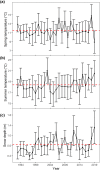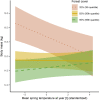Forests buffer the climate-induced decline of body mass in a mountain herbivore
- PMID: 33993622
- PMCID: PMC8361913
- DOI: 10.1111/gcb.15711
Forests buffer the climate-induced decline of body mass in a mountain herbivore
Abstract
Climate change is known to affect key life-history traits, such as body mass, reproduction, and survival in many species. Animal populations inhabiting mountain habitats are adapted to extreme seasonal environmental conditions but are also expected to be especially vulnerable to climate change. Studies on mountain ungulates typically focus on populations or sections of populations living above the tree line, whereas populations inhabiting forested habitats are largely understudied. Here, we investigate whether forested areas can mitigate the impact of climatic change on life-history traits by evaluating the interactive effects of temperature and habitat characteristics on body mass variation in the Alpine chamois Rupicapra rupicapra rupicapra. We examined data of 20,573 yearling chamois collected from 1993 to 2019 in 28 mountain ranges in the Austrian Eastern Alps, characterized by different proportion of forest cover. Our results show that the temporal decline of chamois body mass is less pronounced in areas with greater proportion of forest cover. For chamois living in forest habitats only, no significant temporal change in body mass was detected. Variation in body mass was affected by the interaction between density and snow cover, as well as by the interaction between spring temperatures and forest cover, supporting the role of forests as thermal buffer against the effects of increasing temperatures on life-history traits in a mountain ungulate. In turn, this study suggests a buffering effect of forests against climate change impacts. Assessments of the consequences of climate change on the life-history traits and population dynamics of mountain-dwelling species should thus consider the plasticity of the species with respect to the use and availability of different habitat types.
Keywords: Rupicapra rupicapra; body mass; chamois; climate change; forest; temperature; ungulate.
© 2021 The Authors. Global Change Biology published by John Wiley & Sons Ltd.
Figures




Similar articles
-
Habitat and climate shape growth patterns in a mountain ungulate.Ecol Evol. 2022 Mar 7;12(3):e8650. doi: 10.1002/ece3.8650. eCollection 2022 Feb. Ecol Evol. 2022. PMID: 35309748 Free PMC article.
-
Impact of climate on the population dynamics of an alpine ungulate: a long-term study of the Tatra chamois Rupicapra rupicapra tatrica.Int J Biometeorol. 2018 Dec;62(12):2173-2182. doi: 10.1007/s00484-018-1619-y. Epub 2018 Oct 2. Int J Biometeorol. 2018. PMID: 30276475 Free PMC article.
-
Seasonal diet composition of Pyrenean chamois is mainly shaped by primary production waves.PLoS One. 2019 Jan 23;14(1):e0210819. doi: 10.1371/journal.pone.0210819. eCollection 2019. PLoS One. 2019. PMID: 30673757 Free PMC article.
-
The two sides of border disease in Pyrenean chamois (Rupicapra pyrenaica): silent persistence and population collapse.Anim Health Res Rev. 2015 Jun;16(1):70-7. doi: 10.1017/S1466252315000055. Anim Health Res Rev. 2015. PMID: 26050575 Review.
-
Climate change adaptation for managing non-timber forest products in the Nepalese Himalaya.Sci Total Environ. 2021 Nov 20;796:148853. doi: 10.1016/j.scitotenv.2021.148853. Epub 2021 Jul 3. Sci Total Environ. 2021. PMID: 34265618 Review.
Cited by
-
Weather-dependent changes in habitat use by Alpine chamois.Mov Ecol. 2024 Jan 16;12(1):3. doi: 10.1186/s40462-024-00449-x. Mov Ecol. 2024. PMID: 38229138 Free PMC article.
-
Microclimate temperature effects propagate across scales in forest ecosystems.Landsc Ecol. 2025;40(2):37. doi: 10.1007/s10980-025-02054-8. Epub 2025 Feb 3. Landsc Ecol. 2025. PMID: 39912094 Free PMC article.
-
Antipredator behaviour as a major determinant of prey altitudinal movements: the wolf and the chamois.Front Zool. 2025 Aug 21;22(1):22. doi: 10.1186/s12983-025-00559-1. Front Zool. 2025. PMID: 40841652 Free PMC article.
-
Habitat and climate shape growth patterns in a mountain ungulate.Ecol Evol. 2022 Mar 7;12(3):e8650. doi: 10.1002/ece3.8650. eCollection 2022 Feb. Ecol Evol. 2022. PMID: 35309748 Free PMC article.
-
Projection of current and future distribution of adaptive genetic units in an alpine ungulate.Heredity (Edinb). 2024 Jan;132(1):54-66. doi: 10.1038/s41437-023-00661-2. Epub 2023 Dec 11. Heredity (Edinb). 2024. PMID: 38082151 Free PMC article.
References
-
- Akaike, H. (1973). Information theory and an extension of the maximum likelihood principle. Proceedings of the 2nd international symposium on information theory. In Petrov B. N. & Csaki F. (Eds.), Second international symposium on information theory (pp. 267–281). Akadémiai Kiadó.
-
- Ascenzi, P., Clementi, M. E., Condò, S. G., Coletta, M., Petruzzelli, R., Polizio, F., Rizzi, M., Giunta, C., Peracino, V., & Giardina, B. (1993). Functional, spectroscopic and structural properties of haemoglobin from chamois (Rupicapra rupicapra) and steinbock (Capra hircus ibex). Biochemical Journal, 296(2), 361–365. 10.1042/bj2960361 - DOI - PMC - PubMed
-
- Barton, K. (2020). MuMin: Multi model inference. (R package version 1.15.6.). https://cran.r‐project.org/web/packages/MuMIn/index.html
MeSH terms
LinkOut - more resources
Full Text Sources
Other Literature Sources

